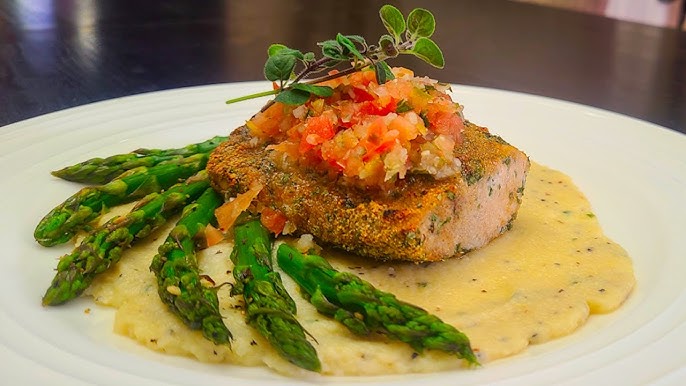Baked Mahi Mahi Recipe: If you’re on the hunt for a delicious, easy-to-make, and healthy seafood dish, baked Mahi Mahi might just be your new go-to.
This tropical fish isn’t just tasty—it’s also versatile and cooks quickly, making it perfect for weeknight dinners or special occasions alike.
Whether you’re a seasoned cook or just starting out in the kitchen, this step-by-step guide will walk you through everything you need to know to make perfectly baked Mahi Mahi every single time.
Why Choose Mahi Mahi?
Mahi Mahi, also known as dolphinfish (but not to be confused with dolphins!), is a popular saltwater fish known for its firm texture and slightly sweet flavor. What makes Mahi Mahi a favorite among seafood lovers is its ability to hold up well to various cooking methods—especially baking.
Baking Mahi Mahi helps to lock in moisture and enhance the natural flavors without overpowering the delicate profile of the fish. It pairs beautifully with a wide range of seasonings, herbs, and marinades, making it easy to customize to your taste. Plus, it doesn’t have an overly “fishy” smell, which is a win for anyone who’s not into strong seafood aromas.
Health Benefits of Mahi Mahi
Mahi Mahi isn’t just flavorful—it’s also a nutritional powerhouse. Here are some of the key health perks of incorporating Mahi Mahi into your diet:
- Low in Fat: One of the leanest fish available, making it perfect for those watching their fat intake.
- High in Protein: A 6-ounce fillet packs around 30 grams of high-quality protein.
- Rich in Omega-3 Fatty Acids: Supports heart health and helps reduce inflammation.
- Loaded with Vitamins and Minerals: Including Vitamin B12, selenium, potassium, and niacin.
Including Mahi Mahi in your meals not only boosts your protein intake but also contributes to overall wellness without packing on the calories.
Ingredients You’ll Need
Before you dive into baking, let’s gather everything you need. Here’s a simple, no-fuss ingredient list to start with:
- 2–4 Mahi Mahi fillets (about 6 oz each)
- 2 tablespoons olive oil or melted butter
- Juice of 1 lemon
- 2–3 cloves of garlic, minced
- 1 teaspoon paprika
- 1 teaspoon dried oregano or thyme
- Salt and pepper to taste
- Fresh parsley or cilantro for garnish
Optional:
- Sliced cherry tomatoes, olives, or capers for added flavor.
This combination strikes the perfect balance between citrusy freshness, savory herbs, and a subtle kick from the garlic and paprika. It’s flavorful without being overwhelming—ideal for showcasing the natural taste of the Mahi Mahi.
Fresh vs. Frozen Mahi Mahi
Wondering whether to go with fresh or frozen fillets? Don’t stress—both can yield delicious results as long as they’re high quality.
- Fresh Mahi Mahi will always be your best bet if you can get it. Look for fillets that are firm, shiny, and have a mild smell.
- Frozen Mahi Mahi is totally fine too—just make sure it’s been properly thawed. Let it sit in the fridge overnight or use the cold-water method for a faster thaw. Never microwave it or leave it on the counter.
No matter which you choose, pat the fish dry with paper towels before seasoning to help the flavors stick and ensure even cooking.
Flavor Boosters – Herbs, Spices & More
The beauty of Mahi Mahi is that it works with both simple and bold flavors. Here are some fun ways to switch things up:
- Spice blends: Cajun, blackened seasoning, or lemon pepper
- Citrus: Lime or orange zest adds a twist to your classic lemon marinade
- Herbs: Fresh dill, basil, or chives can give your dish a garden-fresh feel
- Extras: A drizzle of honey or balsamic glaze can add a sweet-savory contrast
Now that you’ve got the basics down, we’re ready to get into the prep and cooking process.
Tools and Equipment
When it comes to baking Mahi Mahi, the good news is you don’t need any fancy kitchen gadgets. Just a few basic tools and you’re good to go!
Kitchen Tools for Baking Mahi Mahi
Here’s a list of essentials you’ll want to have on hand before you start:
- Baking Dish or Sheet Pan: A ceramic or glass baking dish works great. If you’re cooking for a crowd, a sheet pan can help you fit more fillets at once.
- Aluminum Foil or Parchment Paper: This helps prevent sticking and makes cleanup easier.
- Brush or Spoon: For applying marinades or olive oil.
- Sharp Knife: For cutting garlic, herbs, or trimming the fillets.
- Zester or Grater: Optional but helpful for citrus zesting.
- Digital Meat Thermometer: Not essential, but great for checking doneness without guesswork.
Having these tools ready ensures a smooth cooking process. Remember—preparation is half the battle in cooking!
Preparing Your Mahi Mahi
Now that you’ve got your ingredients and tools, it’s time to prep your fish. This step can make or break your dish, so take your time and do it right.
How to Properly Clean and Cut the Fillets
Even if you buy your Mahi Mahi filleted, it’s good to give it a quick check:
- Rinse the fillets under cold water and pat dry with paper towels. Dry fish = better seasoning and browning.
- Remove any pin bones left in the fillet. You can use clean tweezers or a fish bone puller.
- Trim uneven edges so the fillets cook evenly. If they’re too thick, you can slice them in half horizontally.
This part might feel tedious, but it ensures a more professional and polished final dish.
Marinating for Maximum Flavor
Marinating Mahi Mahi helps to infuse flavor and tenderize the fish. Here’s a simple marinade you can whip up in minutes:
Basic Marinade:
- 2 tbsp olive oil
- Juice of 1 lemon
- 2 garlic cloves, minced
- 1 tsp paprika
- 1 tsp dried oregano
- Salt and pepper to taste
Instructions:
- Mix all the ingredients in a bowl.
- Place the fillets in a zip-lock bag or shallow dish.
- Pour the marinade over the fillets and turn to coat evenly.
- Cover and refrigerate for 15–30 minutes (no more than an hour or the citrus can “cook” the fish).
This simple step takes the flavor from good to amazing, so don’t skip it unless you’re really in a rush.
Baking Instructions – Step by Step
Ready to get cooking? Let’s walk through the baking process from start to finish. Follow these steps and your Mahi Mahi will come out moist, flaky, and full of flavor.
Preheating and Prepping Your Oven
First things first, preheat your oven to 400°F (200°C). This is the sweet spot that cooks the fish quickly without drying it out.
While the oven heats:
- Lightly grease your baking dish or line it with parchment paper or foil.
- Arrange your fillets in a single layer—don’t overlap them.
- Pour any leftover marinade over the top for extra moisture.
Preheating is key. You want the fish to start cooking as soon as it hits the heat, not slowly warm up with the oven.
Lining Your Baking Dish Correctly
Using foil or parchment paper in your baking dish helps in several ways:
- Prevents the fish from sticking
- Makes cleanup a breeze
- Helps retain moisture by folding the foil over the top for a steaming effect
If you’re baking skin-on fillets, place them skin-side down so the skin gets crisp and doesn’t stick.
Want an even juicier result? Cover the dish with foil during the first half of cooking, then remove it for the final 5–7 minutes to let the top brown slightly.
Cooking Time and Temperature Tips
Baking fish is all about timing. Here’s the golden rule:
Bake for 12–15 minutes for 1-inch thick fillets at 400°F.
Use these signs to know your Mahi Mahi is done:
- It flakes easily with a fork
- It turns opaque all the way through
- The internal temperature hits 137°F–145°F
Avoid overbaking! Dry Mahi Mahi is nobody’s friend. Keep an eye on it, especially during the last few minutes.
Want to add some toppings like breadcrumbs or Parmesan cheese? Sprinkle them on during the final 5 minutes so they get golden and crisp without burning.
Serving Suggestions
Baked Mahi Mahi is super versatile when it comes to serving. You can keep it light and fresh, go hearty and comforting, or make it fancy for a special dinner. Whatever your vibe is, there’s a perfect side dish or presentation style to match.
Best Side Dishes with Baked Mahi Mahi
Choosing the right sides can take your Mahi Mahi meal to the next level. Here are some tasty options that pair beautifully:
1. Rice and Grains
- Lemon herb rice: The citrusy notes echo the flavors in the fish.
- Quinoa or couscous: Light and fluffy, and they absorb any sauce you serve with the fish.
2. Roasted or Steamed Vegetables
- Asparagus, zucchini, or bell peppers: Toss in olive oil, salt, and pepper, and roast for a vibrant, colorful plate.
- Green beans almondine: Adds crunch and richness to balance the lightness of the fish.
3. Fresh Salads
- Greek salad: The briny olives and feta complement the flaky Mahi Mahi beautifully.
- Avocado corn salad: Offers creaminess and a touch of sweetness.
4. Mashed or Roasted Potatoes
- Classic, comforting, and always a hit.
5. Tacos or Wraps
- For something different, flake your baked Mahi Mahi and add it to soft tortillas with slaw, avocado, and a drizzle of spicy mayo.
Mix and match these sides to suit your occasion, whether it’s a quick weeknight meal or a sit-down dinner party.
Garnishing Tips for Restaurant-Style Presentation
You eat with your eyes first, right? Garnishing your baked Mahi Mahi can turn a simple dish into a wow-worthy plate. Here’s how to do it:
- Fresh herbs: Sprinkle chopped parsley, cilantro, or dill over the top for a burst of color and freshness.
- Citrus slices: Add thin slices or wedges of lemon or lime for brightness—and to remind your guests of what’s inside.
- Drizzles and sauces: A light drizzle of olive oil, garlic butter, or balsamic glaze looks and tastes incredible.
- Edible flowers: If you’re feeling extra, a couple of edible flowers can make your plate look gourmet in seconds.
And don’t forget to plate with intention. Place the fillet on one side, lean the sides neatly, and serve with a fresh lemon wedge. Your guests will think they’re dining at a five-star seafood restaurant.
Tips and Tricks for Perfect Results Every Time
Making baked Mahi Mahi isn’t hard, but a few extra tips can make the difference between “meh” and “mouthwatering.”
1. Don’t Overcook It Seriously, this is the #1 rule. Fish cooks fast, and dry Mahi Mahi is a tragedy. Use a timer and check for doneness at the 12-minute mark.
2. Use Quality Ingredients Fresh herbs, real garlic, and good olive oil make all the difference in a simple recipe like this.
3. Let It Rest Just like meat, fish benefits from a brief rest. Let your baked Mahi Mahi sit for 2–3 minutes after taking it out of the oven. This helps redistribute the juices and keeps it moist.
4. Don’t Skip the Marinade Even a quick 15-minute soak can elevate your flavor game big time.
5. Customize Your Seasoning Try Cajun spices for heat, coconut milk for a tropical twist, or even a Parmesan crust for something rich and indulgent.
Once you get the hang of it, you’ll find that baked Mahi Mahi is one of those dishes that never fails. It’s quick, healthy, and absolutely delicious.
Common Mistakes to Avoid When Baking Mahi Mahi
Let’s save you from some kitchen facepalms. These are the common mistakes people make with baked Mahi Mahi—and how to avoid them:
1. Skipping the Drying Step If you don’t pat your fish dry, you’ll end up with soggy fillets that don’t brown well and won’t hold the marinade properly.
2. Using the Wrong Pan A dish that’s too big lets the marinade spread out instead of staying close to the fish. Use a snug baking dish to keep everything flavorful and moist.
3. Not Monitoring Cooking Time We’ve said it before and we’ll say it again: don’t overbake. Check your fillets early and use a thermometer if you can.
4. Seasoning Only the Top Lift the fillets and season both sides for balanced flavor. The bottom deserves love too!
5. Forgetting the Rest Time Cutting into the fish right away lets all the juices run out. Let it chill for a couple of minutes—your taste buds will thank you.
Learning from these common pitfalls means your baked Mahi Mahi will come out top-notch every time.
FAQs About Baked Mahi Mahi Recipe
Q1: What does mahi mahi taste like?
Mahi mahi has a mildly sweet, slightly firm flesh with a lean texture—like a cross between cod and halibut. It’s not “fishy,” which makes it perfect for picky eaters or seafood newbies.
Q2: Do I need to marinate mahi mahi before baking?
Nope, not a must. But marinating it for 15–30 minutes in lemon juice, garlic, and olive oil enhances flavor. Just don’t over-marinate—it can break down the fish.
Q3: How long should I bake mahi mahi?
At 400°F (200°C), bake mahi mahi for 12–15 minutes depending on thickness. It’s ready when it flakes easily with a fork and reaches an internal temp of 137°F (58°C).
Q4: Can I use frozen mahi mahi?
Absolutely. Just make sure to thaw it fully and pat it dry before seasoning or baking to avoid sogginess.
Q5: What’s the best seasoning for baked mahi mahi?
Simple wins: garlic powder, paprika, salt, pepper, lemon juice, and fresh herbs like parsley or thyme. For extra flair, add a tropical salsa or garlic butter on top.
Q6: Is mahi mahi healthy?
Yes! It’s low in fat, high in protein, and packed with omega-3s, B vitamins, and selenium. A great choice for a clean, heart-healthy meal.
Q7: What sides go well with baked mahi mahi?
Think fresh and vibrant: roasted veggies, rice pilaf, quinoa salad, or a citrusy slaw. It also pairs beautifully with mango salsa or grilled asparagus.
Conclusion
And there you have it—a foolproof guide to making the best baked Mahi Mahi of your life. From picking the perfect fillets and seasoning them just right, to baking them to golden perfection and pairing with mouthwatering sides, you’re fully set up for success.
Whether you’re cooking for yourself, your family, or guests, baked Mahi Mahi is a healthy, quick, and delicious option that never disappoints. With just a few ingredients and simple steps, you can create a restaurant-quality seafood dish right at home.
So next time you see Mahi Mahi at the store, grab it—and let this guide lead you to a flavor-packed victory.



